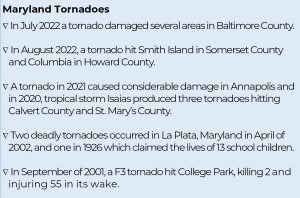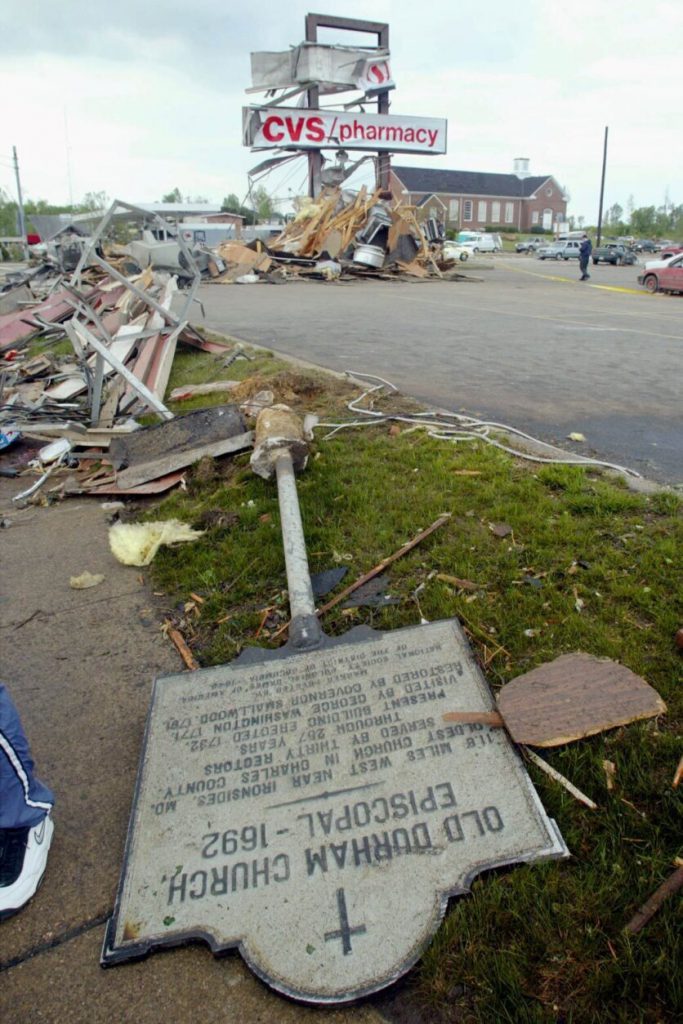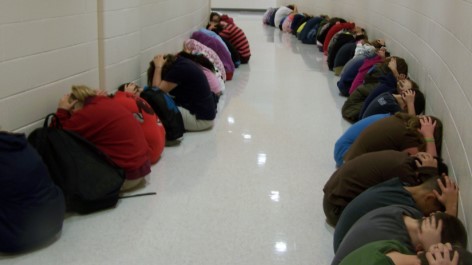How to Stay Safe During Severe Weather Season

A tornado touched down in Rising Sun in Cecil County on April 1st, and recent tornadoes in Georgia and Mississippi remind us spring tornado season is upon us. When a tornado hit Jacksboro Elementary School in Jacksboro, Texas, prior emergency planning and drills were credited with saving the lives of students, faculty and parents.
The Maryland Center for School Safety has partnered with the Maryland Department of Emergency Management (MDEM,) to help prepare for tornado season and plan for an emergency. We spoke to MDEM’s Communications Department about severe weather awareness initiatives. They want to remind everyone to be cognizant tornadoes can happen with little warning. As with all emergency situations, preparation, planning, and practice help to mitigate harm.
Awareness

Tornadoes are thought to be mainly in the Midwest and Central plains area, but they do occur frequently in Maryland. “A tornado can spawn up from a thunderstorm without a tornado watch or warning in place,” says Edward McDonough, MDEM’s Public Information Officer. Therefore, it is important for Marylanders to plan and practice for tornadoes. He says the most critical way to survive a tornado is for a facility to have a reliable, effective way to be alerted to the existence of a warning. Make sure your location finder/locations services is active on your cell phone and do not turn off emergency alerts. Secondly, know your building and execute your safety plan to safe shelter if a tornado is nearby.
School administrators plan and practice for many building emergencies. Tornadoes are different from other weather hazards because there are several steps to get to safety. “With a tornado, it doesn’t matter where you are, if you are inside or outside; you have to follow several steps,” says Jorge Castillo, MDEM’s Spokesperson and Branch Manager. Establishing shelter areas, evacuation routes to the shelter, and how many people will be seeking shelter are all important considerations. “Have a plan. Practice the plan. And when it’s time, execute the plan.”
Tornado WATCH and Tornado WARNING-Know the Difference
Although tornadoes can happen without warning, meteorologists do know when the conditions are right for a tornado. During this time, the National Weather Service (NWS) will issue a tornado WATCH through the Emergency Alert System (EAS.) Watch for alerts on your phone from EAS or NOAA Weather Radio. If you have an emergency radio, make sure the batteries are fresh and designate a staff member to listen for weather alerts.
A tornado WATCH may last for a short time, or several hours, and includes a wide area. It does not indicate danger is imminent. During a WATCH, be attentive to the conditions outside and prepare staff for possible emergency situations. A WATCH should not impair normal school activities, arrival or dismissal.
Unlike a watch, a tornado WARNING means a tornado is occurring, imminent, or likely to occur in the location indicated and is threatening to life and property. When NWS issues the WARNING through the EAS, it is critical to listen to the details of the location of the funnel cloud and the direction it is moving. Tornado WARNINGS may be issued when the funnel cloud is seen in the air, or when it has actually touched down on the ground.

A tornado on the ground is deadly and you will have only seconds to seek shelter. Unlike a WATCH, a tornado WARNING will be issued for a brief amount of time as the funnel cloud travels. With concentrated wind speeds 80-300 miles per hour, tornadoes are serious dangers to lives and property, and it is important to recognize their signs:
- Dark, greenish sky
- Large hail
- Sudden stillness and change of air pressure
- Funnel shaped cloud or cloud of debris near the ground
- A large, dark, low-lying cloud
- Loud roar, similar to a freight train
Stay in your shelter and listen to your local emergency broadcasts until the warning has expired.
For School Administrators
Reinforce with students and staff the difference between a WATCH and a WARNING. Instances of a tornado WATCH should be communicated to staff and clearly direct all activities to remain indoors until further notice. Consider having students and staff in modular classrooms move indoors if an instruction area can be provided.
Any tornado WARNING in your location should be taken with immediate response. Immediately announce to students and staff to take tornado action steps. During the warning, listen to the EAS for updates, allowing you to track the tornado’s direction.
Notification-develop a method to notify everyone to seek shelter. It could be a speaker system, special tone, or bell, but ensure you have a backup method (air horn or megaphone) in case you lose electricity. Ensure everyone knows the notification sound. If your community has tornado sirens, become familiar with the warning tone.

- Prepare-determine the innermost (away from windows and doors), and lowest locations within your building, where students would relocate to in the event of a tornado. Designate specific areas for each classroom. Talk through, and then walk through the procedure with staff in advance of them teaching and rehearsing the procedure with students.
- Practice-conduct exercises with students, staff, and bus drivers. Take time to talk about the exercise when it concludes with students and answer any questions or concerns. Meet with staff when students leave for the day to make any modifications to procedures and respond to concerns.
- Plan-make a plan for notifying staff who may be outdoors at the time of a watch or warning. Consider having staff and students remaining indoors if there is a tornado WATCH in effect. Students and staff who may be in a modular classroom should be given a designated area inside of the school building to provide instruction when a watch is in effect. Remember a WARNING means a tornado is imminent and moving from a modular into the building is less desirable then moving to another location while already inside of the school.
- Communication-be prepared to communicate with parents when conducting a drill about what is expected of them in the event of a tornado and reassure them students and staff are prepared for safety at the school. In the event of an actual emergency, plan for ways to communicate any critical information from your shelter location.
- Pay attention to weather reports. Meteorologists can predict when conditions are right for a tornado.
Practice your plans
Although executing practice tornado drills is complicated for schools, drills are essential in minimizing injury and death. MCSS has provided this tabletop to help you prepare and drill for tornadoes. Practice utilizing your warning system, having students go to designated shelter areas and getting into position. Practice at different times of day. Practice as if you will have substitute teachers, persons with special needs, and potential visitors in the building. After performing a drill, it is critical to evaluate the execution and look for problems needing to be addressed.
The video of Jacksboro Elementary School proves the importance of tornado drills and keeping children calm during an emergency. Mr. Castillo says drills build muscle memory in the students. “Practice makes perfect.” Mr. McDonough agrees saying practice benefits everyone by creating calmness if an emergency arises. “Keep the kids calm, because it’s a lot easier to get kids to move safely around a building for a tornado drill if they are doing it calmly.
Both Emergency Managers encourage students to share what they learn at school during drills with their parents and initiate practice drills in their home. Remember with awareness, planning, preparation, and practice; you will increase the likelihood of surviving a tornado, making storm season in Maryland a breeze.
It’s important to designate storm shelter areas prior to storm season.
Download MDEM’s Tornado Safety Planning For Schools here.
For a comprehensive guide to severe storm safety, please see MDEM’s tornado information and the Maryland Emergency Management site.
Video credit Spectrum News/Brian Scott
